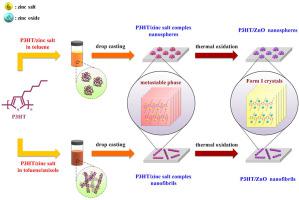Polymer ( IF 4.1 ) Pub Date : 2021-01-12 , DOI: 10.1016/j.polymer.2021.123385 Yi-Huan Lee , Pin-Sheng Yeh , Ying-Tien Hsu , Zheng-Hao Tong , Chin-Hsien Chiang

|
This study explored the detailed solution self-assembly of a P3HT/zinc salt complex system as well as the following in situ growth mechanism of ZnO nanocrystals within self-assembled nanotemplates. Through controlling the solvent selectivity and aging conditions, the geometric shape of the complex system could be directly tailored in solution, forming nanoscopic spheres or highly elongated nanofibrils. These solution self-assembled nanostructures could be efficaciously transferred onto substrates to fabricate nanostructured hybrid films through drop casting. In contrast to traditional P3HT systems with only form Ⅰ crystalline structure, nanostructured P3HT complex thin films revealed a metastable crystalline phase with overlapping alkyl side chains. The formation of this interdigitated crystalline feature could be attributed to the solvent evaporation‐induced crystallization of tightly assembled complex chains existing in solution self-assembled nanostructured domains. The nanostructured P3HT/zinc salt complex assemblies were further used as nanoreactors for the in situ growth of ZnO. As complex samples were thermally treated, a phase transformation of P3HT from the metastable crystalline phase to form Ⅰ structure as well as the formation of ZnO nanocrystals were clearly observed. Both nanospherical and nanofibrillar structured P3HT/ZnO hybrids exhibited lower photoluminescence intensity than did a P3HT/ZnO blend sample. In particular, the nanofibrillar structured hybrid provided an optimized donor/acceptor structure for exciton dissociation as well as interpenetrating nanochannels for charge transport, resulting in the most effective photoluminescence quenching effect among measured samples. We believe that our study can serve as a model system and provide guidelines for efficiently controlling the hierarchical structures of π-conjugated polymer/inorganic nanocrystal hybrids through the in situ synthesis, offering benefits for advanced photoelectronic applications.
中文翻译:

有效控制P3HT /锌盐复合物的溶液自组装以原位模板合成P3HT / ZnO纳米杂化物
这项研究探索了P3HT /锌盐复合物系统的详细溶液自组装,以及在自组装纳米模板中ZnO纳米晶体的以下原位生长机理。通过控制溶剂的选择性和老化条件,可以直接在溶液中调整复杂系统的几何形状,形成纳米球或高度伸长的纳米原纤维。这些溶液自组装的纳米结构可以有效地转移到基底上,以通过滴铸法制造纳米结构的杂化膜。与仅具有Ⅰ型晶体结构的传统P3HT体系相反,纳米结构的P3HT复合薄膜显示出具有亚烷基重叠侧链的亚稳晶相。这种相互交叉的结晶特征的形成可能归因于溶剂蒸发诱导的溶液自组装纳米结构域中紧密组装的复杂链的结晶。纳米结构的P3HT /锌盐复合物组件进一步用作纳米反应器,用于ZnO的原位生长。通过对复杂样品进行热处理,可以清楚地观察到P3HT从亚稳晶相到形成Ⅰ结构的相变以及ZnO纳米晶体的形成。纳米球形和纳米原纤维结构的P3HT / ZnO杂化物均显示出比P3HT / ZnO共混物样品低的光致发光强度。特别是,纳米原纤维结构的杂化体为激子解离提供了优化的供体/受体结构,并为电荷传输提供了互穿的纳米通道,从而在被测样品中产生了最有效的光致发光猝灭效果。我们相信我们的研究可以作为模型系统,并为通过原位合成有效控制π-共轭聚合物/无机纳米晶体杂化体的层次结构提供指导,为先进的光电应用提供了好处。









































 京公网安备 11010802027423号
京公网安备 11010802027423号